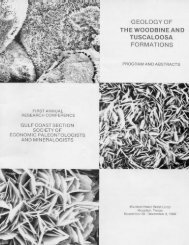Petroleum Systems of Deep-Water Basins - Gulf Coast Section SEPM
Petroleum Systems of Deep-Water Basins - Gulf Coast Section SEPM
Petroleum Systems of Deep-Water Basins - Gulf Coast Section SEPM
You also want an ePaper? Increase the reach of your titles
YUMPU automatically turns print PDFs into web optimized ePapers that Google loves.
geology are unable to satisfactorily backstrip and/or forward-model the interpreted geology. Stretching-factors<br />
derived from summing the fault-heaves across the Faeroe-Shetland basin system simply do not match the stretchingfactors<br />
derived from subsidence calculations or the stretching-factors derived from measurements <strong>of</strong> crustal-thinning.<br />
This prompts one to believe that either something is amiss with the reconstruction approach, or that the input interpretation<br />
and/or our assumptions about the basin history are flawed.<br />
Triassic/Early Jurassic deformation in Western Europe was partitioned into a broad rift-system that linked from<br />
continental Europe, through the North Sea, and northwards into the East Greenland/Norway system. This rift-system<br />
also extended along the western margin <strong>of</strong> Ireland and the UK where it reactivated many older post-Caledonian basinal<br />
elements. It is important to note, however, that the subsequent Middle to Late Jurassic rift-system, so prominent in<br />
mid-Norway and the North Sea, did not extend in any substantial way through the Faeroe Shetland basin-system.<br />
Plate reconstructions, made using the program PLATES, suggest that Jurassic rifting was partitioned principally into a<br />
system that extended from the Arctic Ocean, through the Norwegian Sea, the North Sea and across Continental<br />
Europe. According to the plate reconstructions, the main phase <strong>of</strong> rifting between Greenland and the Faeroes/UK did<br />
not begin until the mid-Cretaceous, ca. 120Ma.<br />
The initial motion between Greenland and the Faeroes/UK (ca. 120Ma–95Ma) was oblique to the trends <strong>of</strong> earlier<br />
basins in the Faeroe-Shetland basin-system that were more northeast-southwest. Reconstruction strategies must accurately<br />
account for the oblique character <strong>of</strong> the rifting, otherwise anomalously low estimates for fault heave may occur.<br />
It is also important to recognise that in oblique-rift settings, very high crustal stretches can occur. In fact, high-stretch<br />
numerical forward models can replicate many features (e.g., the form <strong>of</strong> the ridges that frame the basin, the intra-rift<br />
ridges, and the syn- and post-rift stratal stacking patterns) <strong>of</strong> the observed basin.<br />
A tectonic model is thus emerging for the West Shetland region in which the main rift event responsible for establishing<br />
the Faeroe-Shetland basin system as a major sediment depocenter began in the mid-Cretaceous. The stretching<br />
direction is initially oblique to earlier basin trends and eventually had a very-high stretch. These observations are <strong>of</strong><br />
fundamental significance because the magnitude, direction, and timing <strong>of</strong> rifting ultimately controlled key parameters<br />
<strong>of</strong> the petroleum system. The distribution <strong>of</strong> source, reservoir and seal rocks and the timing and generation <strong>of</strong> hydrocarbons<br />
with respect to structural development are all a function <strong>of</strong> the rift history.<br />
The opening between Greenland and the UK changed significantly late in the Cretaceous (~85Ma), as the direction<br />
<strong>of</strong> rifting became more orthogonal to the present plate boundary. This important period <strong>of</strong> extension in the<br />
Faeroe-Shetland basin system continued into the late Paleocene. Many <strong>of</strong> the main basin elements (viz., Corona ridge,<br />
Westray ridge, Flett ridge, and Rona ridge) owed their current “form” to this Paleocene extension that was the precursor<br />
to the early Eocene breakup. Following break-up <strong>of</strong> the North Atlantic in the early Eocene, rapid post-rift basin<br />
subsidence, possibly caused by depth-dependent stretching, created a deepwater trough—the Faeroe-Shetland channel—in<br />
which water depths are in excess <strong>of</strong> 1700 m.<br />
34

















